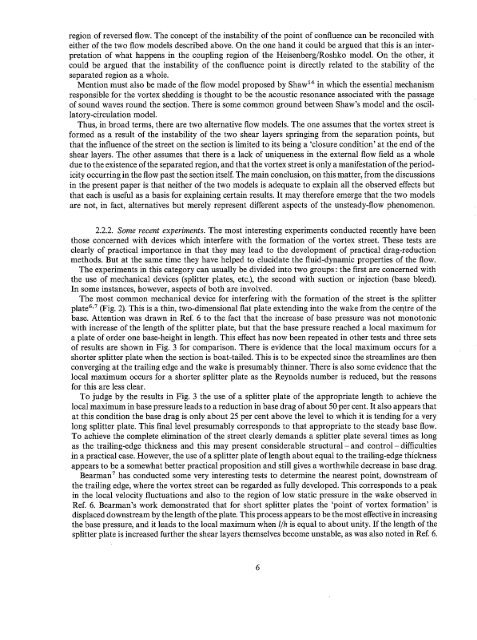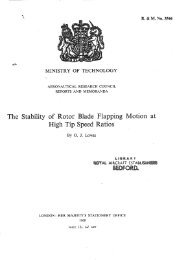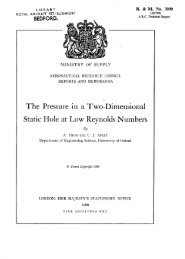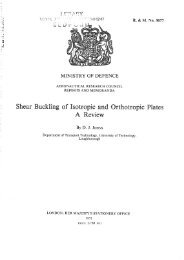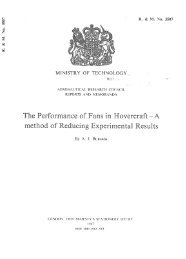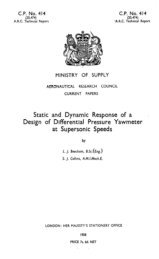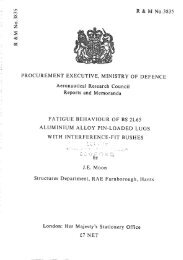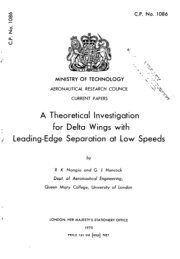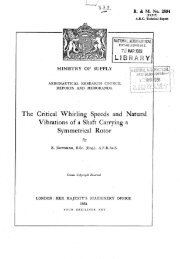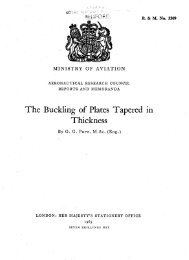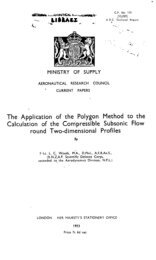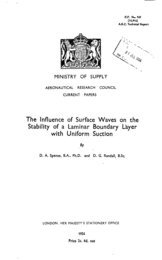A Discussion of Two-Dimensional Turbulent Base Flows - aerade
A Discussion of Two-Dimensional Turbulent Base Flows - aerade
A Discussion of Two-Dimensional Turbulent Base Flows - aerade
Create successful ePaper yourself
Turn your PDF publications into a flip-book with our unique Google optimized e-Paper software.
egion <strong>of</strong> reversed flow. The concept <strong>of</strong> the instability <strong>of</strong> the point <strong>of</strong> confluence can be reconciled with<br />
either <strong>of</strong> the two flow models described above. On the one hand it Could be argued that this is an inter-<br />
pretation <strong>of</strong> what happens in the coupling region <strong>of</strong> the Heisenberg/Roshko model. On the other, it<br />
could be argued that the instability <strong>of</strong> the confluence point is directly related to the stability <strong>of</strong> the<br />
separated region as a whole.<br />
Mention must also be made <strong>of</strong> the flow model proposed by Shaw 14 in which the essential mechanism<br />
responsible for the vortex shedding is thought to be the acoustic resonance associated with the passage<br />
<strong>of</strong> sound waves round the section. There is some common ground between Shaw's model and the oscil-<br />
latory-circulation model.<br />
Thus, in broad terms, there are two alternative flow models. The one assumes that the vortex street is<br />
formed as a result <strong>of</strong> the instability <strong>of</strong> the two shear layers springing from the separation points, but<br />
that the influence <strong>of</strong> the street on the section is limited to it s being a 'closure condition' at the end <strong>of</strong> the<br />
shear layers. The other assumes that there is a lack <strong>of</strong> uniqueness in the external flow field as a whole<br />
due to the existence <strong>of</strong> the separated region, and that the vortex street is only a manifestation <strong>of</strong> the period-<br />
icity occurring in the flow past the section itself. The main conclusion, on this matter, from the discussions<br />
in the present paper is that neither <strong>of</strong> the two models is adequate to explain all the observed effects but<br />
that each is useful as a basis for explaining certain results. It may therefore emerge that the two models<br />
are not, in fact, alternatives but merely represent different aspects <strong>of</strong> the unsteady-flow phenomenon.<br />
2.2.2. Some recent experiments. The most interesting experiments conducted recently have been<br />
those concerned with devices which interfere with the formation <strong>of</strong> the vortex street. These tests are<br />
clearly <strong>of</strong> practical importance in that they may lead to the development <strong>of</strong> practical drag-reduction<br />
methods. But at the same time they have helped to elucidate the fluid-dynamic properties <strong>of</strong> the flow.<br />
The experiments in this category can usually be divided into two groups: the first are concerned with<br />
the use <strong>of</strong> mechanical devices (splitter plates, etc.), the second with suction or injection (base bleed).<br />
In some instances, however, aspects <strong>of</strong> both are involved.<br />
The most common mechanical device for interfering with the formation <strong>of</strong> the street is the splitter<br />
plate a'7 (Fig. 2). This is a thin, two-dimensional flat plate extending into the wake from the centre <strong>of</strong> the<br />
base. Attention was drawn in Ref. 6 to the fact that the increase <strong>of</strong> base pressure was not monotonic<br />
with increase <strong>of</strong> the length <strong>of</strong> the splitter plate, but that the base pressure reached a local maximum for<br />
a plate <strong>of</strong> order one base-height in length. This effect has now been repeated in other tests and three sets<br />
<strong>of</strong> results are shown in Fig. 3 for comparison. There is evidence that the local maximum occurs for a<br />
shorter splitter plate when the section is boat-tailed. This is to be expected since the streamlines are then<br />
converging at the trailing edge and the wake is presumably thinner. There is also some evidence that the<br />
local maximum occurs for a shorter splitter plate as the Reynolds number is reduced, but the reasons<br />
for this are less clear.<br />
To judge by the results in Fig. 3 the use <strong>of</strong> a splitter plate <strong>of</strong> the appropriate length to achieve the<br />
local maximum in base pressure leads to a reduction in base drag <strong>of</strong> about 50 per cent. It also appears that<br />
at this condition the base drag is only about 25 per cent above the level to which it is tending for a very<br />
long splitter plate. This final level presumably corresponds to that appropriate to the steady base flow.<br />
To achieve the complete elimination <strong>of</strong> the street clearly demands a splitter plate several times as long<br />
as the trailing-edge thickness and this may present considerable structural-and control- difficulties<br />
in a practical case. However, the use <strong>of</strong> a splitter plate <strong>of</strong> length about equal to the trailing-edge th{ckness<br />
appears to be a somewhat better practical proposition and still gives a worthwhile decrease in base drag.<br />
Bearman 7 has conducted some very interesting tests to determine the nearest point, downstream <strong>of</strong><br />
the trailing edge, where the vortex street can be regarded as fully developed. This corresponds to a peak<br />
in the local velocity fluctuations and also to the region <strong>of</strong> low static pressure in the wake observed in<br />
Ref. 6. Bearman's work demonstrated that for short splitter plates the 'point <strong>of</strong> vortex formation' is<br />
displaced downstream by the length <strong>of</strong> the plate. This process appears to be the most effective in increasing<br />
the base pressure, and it leads to the local maximum when l/h is equal to about unity. If the length <strong>of</strong> the<br />
splitter plate is increased further the shear layers themselves become unstable, as was also noted in Ref. 6.


